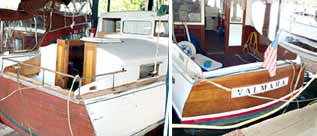|
|
 Where Do Old Boats Go to Retire? Where Do Old Boats Go to Retire?
Rick Meatyard, right, restores antique boats at his Tall Timbers Marina, where he keeps a museum of nautical antiques.
If an old boat is as fortunate as the 1936 38-foot Matthews cabin cruiser that sailed into the hands of Denise and George Klein, owners of Bay Harbor Boatyard in Deale, it may head down to Tall Timbers Marina in St. Mary’s County. There, many an old boat waits to be lovingly restored to its former glory.
More often, their last port of call is the local landfill, where they might arrive in one piece or in countless shards. Others sit out their old age in the shadowy backwaters of quiet creeks where they fade into the scenery, sinking into the muddy waters as rain rots them from the outside.
“Some of the creeks around Deale are just full of these abandoned boats,” says Denise Klein. “It’s kind of spooky, like a graveyard.”
Klein is well acquainted with the ghosts of ships past. She and husband George make a business of disposing of old, ailing or unwanted vessels, usually by hauling them, intact, minus engines and fuel tanks, to a county landfill. There they are hacked into more manageable pieces.
“Many people don’t know that they can do it that way,” says Klein, who charges between $800 and $1,200 for the service. Other businesses, with their own equipment, might do the cruiser chopping on site, which can cost thousands.
This 1936 Matthews, rumored to have originally belonged to P.T. Barnum, managed to escape both abandonment and destruction this summer.
The boat’s most-recent owner had been living aboard. Ready to move on, he came to the Kleins in search of an economical way to get rid of his old home.
“It was a beautiful antique cabin cruiser. The cabinetry alone was so nice I wanted to take it out and bring it home,” said Klein. Inspired to save the old Matthews, George Klein put in a call to Rick Meatyard, owner of Tall Timbers, a 140-slip marina that specializes in restoring the relics of the pre-fiberglass era.
“The Kleins did the right thing,” says Meatyard, who cheerfully adopted the nameless craft, which he calls a “sister boat” to his personal cruiser, Valmara, a restored 1940 Matthews with an identical hull.
 The 1936 Matthews,left, is rumored to have belonged to showman P.T. Barnum. Its sister boat, Valmara, a restored 1940 Matthews, belongs to Rick Meatyard. The 1936 Matthews,left, is rumored to have belonged to showman P.T. Barnum. Its sister boat, Valmara, a restored 1940 Matthews, belongs to Rick Meatyard.
Meatyard’s enthusiasm for things old is reflected throughout his business, which he started with his father, a Montgomery County magistrate, about 40 years ago. Antiques abound: from the gutted 1935 Oldsmobile sitting outside his workshop, to the antique drill press inside; from the ‘museum’ of nautical antiques, including a mid-19th century oyster dredge, to his dog Henry, whose shabbiness attests to the long and happy life of a waterside-dwelling canine.
“Everything here is an old classic, including our staff,” quips Meatyard. In his early 50s, Meatyard himself barely qualifies as classic. It is true, though, that Tall Timbers is a stomping ground for salt-weathered captains and wise old mechanics, including, “one of the few remaining wooden boat masters,” says Meatyard.
Restoring and maintaining antique boats is an expensive, time-consuming hobby, but, Meatyard says, once restored, “these boats can do pretty much anything a comparable newer craft can.”
Valmara, which spends its fair share of time cruising the Bay and the Patuxent River, is a frequent sight at old-boat shows. As soon as his newest acquisition, her younger sister, is shipshape again and with a new name, Meatyard hopes she will, too.
Many of the vessels at his marina belong to customers, most who spend their spare time toiling to bring their treasures back to original splendor. The other boats, some scattered around the grounds, some tucked away in slips, belong to Meatyard or to members of his crew, who seem to be first collectors and artisans, then business people, renovating for love, not money.
Getting back into the water, however, is not always the fortune of antiquated boats. Some are reincarnated into new landlubbing forms.
“I want to make old boats into lawn ornaments even more dramatic than the typical rowboat as a flower bed,” says Joyce Gonia of Fairhaven, an ex-CPA come-craftswoman. In her new business, Shore Things, Gonia, who is restoring a 1963 Boston Whaler of her own, plans to turn old crafts into nautical landscapes and traveling advertisements.
“I’ve seen people use them in all sorts of ways,” says Denise Klein, “from a guy who turned one into a tiki bar to a family that made one into a playhouse for the kids.”
Recycling old boats in any way is better than abandoning them to the elements. The Maryland Department of Natural Resources makes a routine of clearing derelict-inhabited creeks, attempting to bill costs to negligent owners.
“You wonder what the history is: Who would leave them? Why nobody wanted them anymore?” says Klein. “But when there are a lot of these boats sitting around, it is an environmental issue.” Oil and contaminants seep into the water, and the boats themselves become hazards to navigation.
Meatyard, who occasionally finds a gem in a backwater bog, has a collector’s perspective: “It’s actually beautiful in a way, these old boats kind of hiding in the shadows. It’s a nice surprise when you’re exploring the creeks.”
- Rachel Presa
 SACReD Helps Kids Learn to Love the Bay SACReD Helps Kids Learn to Love the Bay
Third-grader Travaughn Coates joined 12 other children in SACReD’s week-long discovery camp.
photo by Amanda Lofton
“I want to go back next year.” Third-grader Travaughn Coates looks wistfully towards the water from the 45 acres of land that is West River United Methodist Center. He remembers the fun of riding, with his fellow campers, on the famous giant yellow tube that is towed behind a power boat.
This was Travaughn’s first time tubing, as well as sailboating, canoeing and swimming in the Bay’s waters. The Shady Side Elementary student was one of 13 children sponsored by the South Arundel Citizens for Responsible Development, SACReD, to attend the week-long overnight Discovery camp through their Junior Ecologist Camp Program. Eleven of the 13 will attend camp July 29 to August 3.
“It’s good for the kids to be around the Bay and learn to care about it,” says SACReD’s program chair Pam Barry. Working with Shady Side Elementary counselor Lisa Blanford and Deale and Tracey’s counselor Irene Reed, Barry identified children who were “without sufficient support systems to attend such a camp.” After three years of increasing sponsorship by SACReD, Barry says “the kids seem to love it.” Previous years’ campers love to come back.
Travaughn is no exception as he talks about the nature hikes he took and animals he saw, both in the woods and in the camp’s Nature Center. Already somewhat knowledgeable from school about the dangers of pollution and the precarious state of the Bay, he reinforced in camp what he’d learned in school. “We learned that polluting makes water bad for fish, and it kills animals,” he recalls.
This understanding is exactly why SACReD member Lynn Kitzmiller decided to become a sponsor this year. “This is a wonderful project. It’s important for kids to know as much as possible about the ecology of their area,” she says. Support of the project from Kitzmiller and her husband, William, extends beyond their own $290 donation. They recommended USinternetworking Charitable Foundation as a possible sponsor for SACReD. As a result, the organization is sponsoring two campers this summer.
In addition to enjoying activities provided by the Bay, the campers join in traditional camp games, songs and devotions around a campfire. The scenic grounds even offer a climbing/rappelling wall about which Travaughn explains “you have to climb all the way up. I made it half way.” Still an impressive feat for a small boy against a 24-foot vertical wall with tiny grips.
Travaughn’s done just what SACReD and these sponsors hope for: He’s met new challenges, gotten to know new friends and become more aware of the environment and the Bay ecosystem. The number of children sponsored for camp has increased from three in 1999 to six in 2000 to this year’s 13 children.
Barry remains hopeful for that pattern to continue. “Optimistically, we could double it again next year,” she says, crediting the support and leadership of the sponsors with the increasing success of the program.
“It would be great to one day have the money to start a science camp in the South County area.” Franklin Point Park, saved by SACReD from development, is SACReD’s dream site. They’ll start the ball rolling early this fall with a trail clean-up and discovery day for the campers, sponsors and their families as well as all children in South County.
- Amanda Lofton and Ariel Brumbaugh
 Silence: Silence:
The Sound of Summer
More than three dozen friends, family and supporters of Happy Harbor chartered a bus to Annapolis for the restaurant’s liquor board hearing.
photo by Sandra Martin
On a hot, steamy evening in the last week of July, more than three dozen people gathered in the heat outside Happy Harbor in Deale to squeeze aboard a charter bus for a 30-minute ride to Annapolis. No sightseers, these people had a specific destination: the County Courthouse for a hearing before the Anne Arundel County Liquor Commission.
Friends and neighbors, patrons and family, all had gathered to show their support for live, weekend music on the deck of Deale’s Happy Harbor Restaurant and Dock Bar.
Long a summer staple along the banks of Rockhold Creek in Deale, music this year was silenced Memorial Day weekend when Happy Harbor owner Barbara Sturgell received a call from her county liquor inspector informing her that a group of neighbors had complained about noise from the restaurant’s bands. Its gist: One person’s music is another person’s noise. Until a hearing before the liquor board, there was to be no more music.
How does live music wind up filling the ears of the County Liquor Commissioners?
It turns out that live music - who can play it, how loud, under what conditions - falls in a jurisdictional twilight zone.
Authority over noise depends on which noise. Animal Control handles animal noise; Department of Natural Resources deals with noisy boats; Department of Transportation oversees highway and air noise; and the police handle loud parties, domestic disputes and booming car stereos.
All goings on — including music — in any licensed establishment serving liquor in Anne Arundel County fall under the oversight of the liquor commission.
But the clearest guidelines of music versus noise come from the state. In 1974, the legislature passed the Environmental Noise Act, which restricts noises to a maximum of 65 decibels in residential areas, 67 decibels in commercial areas and 70 decibels in industrial areas.
A typical conversation from one foot away registers at 60 decibels. Comparatively, 50 decibels would be half as loud; 70 decibels would be twice as loud. For the purposes of noise complaints, those levels apply to where the sound is heard, not where the sound is generated.
Attorney Clayton Mitchell, representing the 10 homeowners who had joined together in the noise complaint, contended that Happy Harbor’s music had “repeatedly violated” the state’s 65 decibel limit in the summer of 2000. His clients had made “several informal complaints directed to the management [of Happy Harbor] and they were ignored.” As a result, his clients petitioned the Liquor Board to deny Happy Harbor its outside liquor license.
The music was “loud enough that we could hear it 300 feet away,” the complaint claimed. At that distance, Mitchell said, it did not drown out conversation. But it was worse, he said, for neighbors closer to the water.
That’s because sound waves skip across water. “On ground, there’s more chance [for the sound waves] to be broken up,” said Rick McIntire, spokesman for Maryland Department of Environment.
“It was like an outdoor rock concert,” exclaimed Debbie Whittington, who lives on Rockhold Creek opposite Happy Harbor.
As an environmental law, oversight of the state’s noise levels and responsibility for investigating complaints resides with Maryland Department of the Environment and its sole Noise Enforcer, Dave Jarinko, who responds to complaints of all sorts from Deep Creek to Ocean City, Baltimore to St. Mary’s City. He deals with noise complaints that cannot be resolved locally, measuring the sounds and showing up in court to offer expert testimony.
Maryland is a big state with a lot of noise for one person to monitor, so Jarinko cannot give on-the-spot service or wait for episodic noise.
So, in the Liquor Commission hearing, Mitchell acknowledged that his clients “don’t have the technical data to back up their claim.” No official noise readings were taken in ’00. This year, music at Happy Harbor was stopped this year before it started; there are no 2001 readings.
“My clients want to be good neighbors and to support local business,” Mitchell explained. With “Happy Harbor’s good-faith assurance” that there will be no further violations of the 65 decibel noise level, Mitchell said, his clients would drop their claim.
This was good news for the liquor board’s chairman, Robert C. Bittner, presiding over a meeting already long.
“We have no problem with Happy Harbor,” Bittner said. “This is a privilege for outside service that has been granted to this licensee for over a decade.” Can Happy Harbor agree to Mitchell’s terms, Bittner asked attorney Robert Sturgell, representing Happy Harbor?
This took the wind out of Stugell’s sails, for he had prepared charts, drawings, plans, sworn statements as well as witnesses from the community and its surrounding businesses — not to mention the three dozen supporters bussed in for the hearing.
“I’d like the people in the community — the business owners, slip holders, residents, neighbors — to have a chance to stand and be recognized for the record,” Sturgell said.
“I hope you all can work this out,” Bittner pressed.
Dealite Norman Broyles, one of the 10 complainants, said after the hearing, “The sad part of it is that all this could have been avoided.”
Sturgell agreed. “All it would have taken,” he said, “was for someone to come over and tell us the music was too loud.”
- J. Alex Knoll with Amanda Lofton

In Anne Arundel, Your Fall Garden Can Be Free
“We call this the largest bird feeder in Anne Arundel County,” says Jane Sinclair, executive director of Unity Gardens, of the expansive meadow of sunflowers ready to burst open with a feast for both birds and eyes. The garden was sown with minimal effort and funds — Sinclair estimates $10 — by students and parents at Millersville Elementary School. Around the perimeter of the school, just outside the windows of every classroom, bluebird boxes make live exhibits for science classes. Out back, persimmon, serviceberry and river birch offer habitat as well as a history lesson on plants used by Native Americans.
Millersville Elementary is one of several stops we make as Sinclair shows off, like a proud parent, some of the 14 gardens made possible through Unity Gardens, a nonprofit organization dedicated to empowering community groups to enhance quality of life in Anne Arundel County through local greening projects. “It’s really about getting people from the community out and working together,” Sinclair explains.
Sponsored by the Severn River Association, Unity Gardens gives grants of up to $1,000 to schools, neighborhoods and other non-profit groups. To be eligible, projects must be located in Anne Arundel County and applicants must have a bank account. Other requirements include attending a resources workshop and planning with a Unity Gardens volunteer.
While environmentally correct gardens are not required, a group’s promise of beneficial impact on the earth as well as plans for maintenance and sustainability are some of the criteria used to award grants. Other criteria include level of volunteer participation and development of community leadership, financial need and feasibility of plans. Funds may be used for plants and materials, such as the barrels that collect rainwater at Arlington Echo’s Rain Gardens.
Pitcher plants and frogs adorn the Rain Gardens at Arlington Echo, the outdoor education center of the Anne Arundel County Schools. Students built the mini-wetlands as a lesson in ecology. Rainwater from roofs as well as runoff from the roads and sidewalks is channeled into two Rain Gardens, where plants filter out excess nutrients and pollutants before the water drains into the Severn River. Groups that focus on environmental education can get additional assistance through the Chesapeake Bay Trust, which co-funded the gardens at Arlington Echo.
At Baldwin Hall on the crossroads of Millersville Road and General’s Highway, a Wedding Garden of yellow coreopsis and black-eyed Susan, orange butterfly weed, red honeysuckle and purple gayfeather and coneflower sets a rainbow-hued backdrop for wedding photos. Other gardens planted in spring 2001 include native azaleas at London Town, a meditation garden at Eastport United Methodist Church and a war memorial garden at Fort Meade Historical Foundation.
Grants are awarded in spring and fall of each year. Make applications for grants for fall 2001 planting through August 15: www.severnriver.org.
- Martha Blume
Way Downstream ...
In Virginia, an important series of stories last week in the Virginian-Pilot newspaper began: “Virginia has spent 13 years and $28 million on a Chesapeake Bay clean-up program that regulators do not enforce, developers easily sidestep and many local governments openly flout.” Learn more at www.pilotonline.com/news/nw0729bay.html …
In Norfolk, apparently you can add judges to the problem: A federal judge is allowing a developer, Newdunn Associates, to fill in sensitive wetlands that a Virginia Institute of Marine Science professor testified filter pollutants from draining into the Chesapeake …
In Nanticoke, a barge has moved in 100 tons of marine limestone to construct Maryland’s first private oyster sanctuary. Partners in the project - aimed at helping watermen as well as filtering the Bay - include the University of Maryland, the Oyster Recovery Partnership and the Chesapeake Bay Foundation …
In California, music devotees are pressing rangers at Joshua Tree National Park to include tourist information on musician Gram Parsons of the Byrds, the first star of country rock, whose body was burned at Joshua Tree, which he loved, after he died of a drug overdose in 1973 …
Our Creature Feature comes from Great Britain, where the Queen’s Swan Marker is operating a little differently these days. Used to be, the monarch owned every swan in the kingdom by royal edict, and the Marker gathered them for the cooking pot.
Rather than royal cooks, the threat to swans these days are foxes, minks and hooligans with BB-guns. Last week, rather than catching the swans, the Marker, clad in scarlet and white and sailing a pennanted skiff, traveled the Thames River to count the swans in a display of conservation. The tally, Reuters reported: 132 cygnets on an 80-mile stretch of river that passes the Windsor Castle on its way to London.
Copyright 2001
Bay Weekly
|